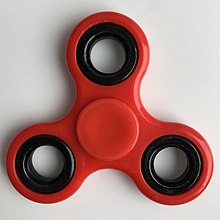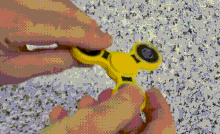Fidget spinner
 A typical three-lobed fidget spinner | |
| Type | Stress-relieving toy |
|---|---|
| Availability | 1993–present |
| Materials | Brass, stainless steel, ceramic, titanium, copper, plastic, latex etc. |


A fidget spinner is a toy that consists of a ball bearing in the center of a multi-lobed (typically two or three) flat structure made from metal or plastic designed to spin along its axis with pressure. Fidget spinners became trending toys in 2017, although similar devices had been invented as early as 1993.[1]
The toy has been promoted as helping people who have trouble focusing or those who may need to fidget to relieve nervous energy, anxiety, or psychological stress. There are claims that a fidget spinner can help calm down people who have anxiety or neurodivergences, like ADHD and autism.[2] However, as of May 2017, there is no scientific evidence that they are effective as a treatment for ADHD.[3][4]
Development
In October 2016,[5] inspired by the Fidget Cube Kickstarter campaign,[6] Allan Maman[7][8] used his Byram Hills High School's 3-D printers to make Fidget360[9] with the help of his physics teacher, Eric Savino [10] and worked with Cooper Weiss to promote the toy.[11]
In an interview appearing on 4 May 2017 on NPR, Scott McCoskery described how he invented a metal spinning device, Torqbar,[12][13] in 2014 to cope with his own fidgeting in IT meetings and conference calls.[14] In response to requests from an online community, he began selling the device online.[14]
Popularity and usage

With the rapid increase in the popularity of fidget spinners in 2017, many children and teenagers began using them in school, and some schools also reported that students were trading and selling the spinner toys.[15][16][17]
As a result of their frequent use by school children, many school districts banned the toy.[18][19] Some teachers argued that the spinners distracted students from their schoolwork.[15] According to a survey conducted by Alexi Roy and published in May 2017, 32% of the largest 200 American public and private high schools had banned spinners on campus.[20]
When fidget spinners rose in popularity in 2017, many publications in the popular press discussed the marketing claims made about them for people with ADHD, autism, or anxiety.[4][18][19] However, there is no scientific evidence that fidget spinners are effective as a treatment for children with ADHD.[3][4][21] They quickly fell in popularity and sales after peaking in May 2017.[22]
Patent status
As of 2017, the patent status of the various fidget spinners on the market was unclear.[23] Catherine Hettinger, a chemical engineer by training, was initially credited by some news stories as having been the inventor of the fidget spinner, including by media outlets such as The Guardian,[18] The New York Times,[19] and the New York Post.[24] Hettinger filed a patent application for a "spinning toy"[25] in 1993 and a patent was issued, but Hettinger allowed the patent to lapse in 2005 after she could not find a commercial partner.[23][18] However, a May 2017 Bloomberg News article showed that Hettinger was not the inventor of the fidget spinner, and Hettinger agreed.[23]
See also
References
- ^ Calfas, Jennifer (May 3, 2017). "Meet the Woman Who Invented Fidget Spinners, the Newest Toy Craze Sweeping America". Money.com. Archived from the original on April 16, 2021. Retrieved August 31, 2018.
- ^ McGri, David (2017-08-18). "Fidget Spinners". Huffington Post. Retrieved 2017-08-21.
- ^ a b Calfas, Jennifer (May 11, 2017). "Do Fidget Spinners Really Help With ADHD? Nope, Experts Say". Money.com. Archived from the original on March 7, 2022. Retrieved May 16, 2017.
- ^ a b c Singh, Anita; Horton, Helena; Fuller, George (May 3, 2017). "Fidget spinners: the new classroom craze being banned across the nation". The Telegraph. Retrieved May 16, 2017.
- ^ Rashid, Brian (May 14, 2017). "How These Two 17-Year-Olds Are Cashing In On The Fidget Spinners Everyone Is Talking About". Forbes.com. Archived from the original on 15 May 2017. Retrieved 16 April 2022.
- ^ "20 in their 20s - Allan Maman". Crain's New York Business. 11 July 2018. Retrieved 16 April 2022.
- ^ "Allan Maman - 17 Year Old with ADHD Created Fidget Spinner Empire!". InspireMyKids. 30 September 2018. Retrieved 16 April 2022.
- ^ Morgan, Nick (2 June 2016). "What were you doing when you were 16? This teen is saving lives". Public Words. Retrieved 16 April 2022.
- ^ "Home". Fidget360. Archived from the original on 6 November 2016. Retrieved 16 April 2022.
- ^ "How 2 teens 3-D printed a fidget spinner empire out of their high school science lab". Mic. Retrieved 16 April 2022.
- ^ Montag, Ali (11 July 2017). "These teens made $350,000 in 6 months helping fidget spinners go viral". CNBC. Retrieved 16 April 2022.
- ^ Gonzalez, Guadalupe (8 June 2017). "The Inside Story Behind the Rapid Rise of the Fidget Spinner Trend". Inc.com. Retrieved 16 April 2022.
- ^ "Millions sold: Was the original fidget spinner made in Suquamish?". The Seattle Times. 17 May 2017. Retrieved 16 April 2022.
- ^ a b Malone, Kenny (May 4, 2017). "Fidget Spinner Emerges As Must-Have Toy Of The Year". Planet Money. NPR. Retrieved May 18, 2017.
- ^ a b Calfas, Jennifer (May 4, 2017). "Here's Everything You Need To Know About Fidget Spinners". Money.com. Archived from the original on October 24, 2020. Retrieved May 6, 2017.
- ^ "Many Schools Ban Hot Toy For Being Distraction". CBS Los Angeles. May 4, 2017. Retrieved May 6, 2017.
- ^ "Fidget Spinners For Kids: Reports Say It's Distracting, Parents Say Not So". CBS Miami. May 2, 2017. Retrieved May 7, 2017.
- ^ a b c d Luscombe, Richard (May 5, 2017). "As fidget spinner craze goes global, its inventor struggles to make ends meet". The Guardian. Retrieved 11 May 2017.
- ^ a b c Williams, Alex (May 6, 2017). "How Fidget Spinners Became a Hula-Hoop for Generation Z". The New York Times.
- ^ Roy, Alexi (May 10, 2017). "The Fidget Spinners Are Banned in 32% of the Largest High Schools U.S." Spinner List. Archived from the original on September 15, 2017. Retrieved June 5, 2017.
- ^ Bogost, Ian. "The Fidget Spinner Explains the World". The Atlantic. Retrieved 2017-07-09.
- ^ "Get Over It. Fidget Spinner Trend Is Dead". Fortune. Retrieved Sep 1, 2020.
- ^ a b c Brustein, Joshua (May 11, 2017). "How the Fidget Spinner Origin Story Spun Out of Control". Bloomberg News. Retrieved May 12, 2017.
- ^ Miller, Joshua Rhett (May 5, 2017). "Woman who invented fidget spinners isn't getting squat". New York Post.
- ^ US 5591062A, Catherine A. Hettinger (Disputed), "Spinning toy", published 1997-01-07, issued 1997-01-07
External links
 Media related to Fidget spinners at Wikimedia Commons
Media related to Fidget spinners at Wikimedia Commons The dictionary definition of fidget spinner at Wiktionary
The dictionary definition of fidget spinner at Wiktionary
